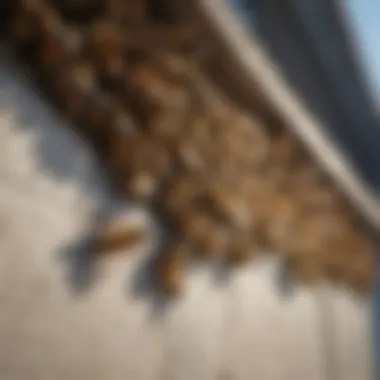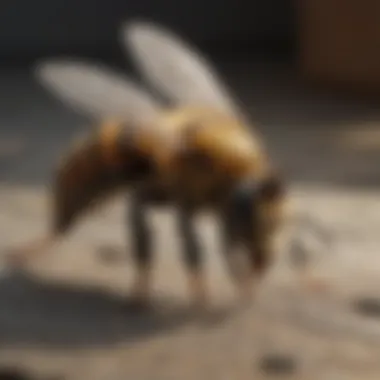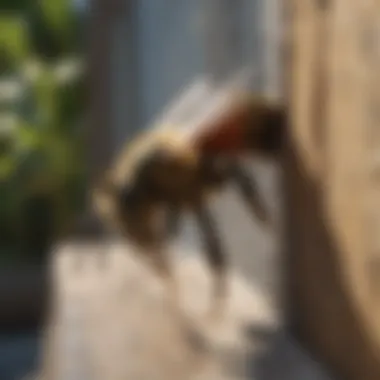Effective Strategies for Removing Bees from Siding


Intro
Bees play a crucial role in our ecosystem, contributing to pollination and biodiversity. However, when they choose to nest within the siding of our homes, it raises valid concerns for homeowners. The presence of bees can lead to safety issues for residents, particularly for those who are allergic. This article aims to discuss effective strategies for safely and effectively removing these insects from house siding.
The first step in addressing this issue is understanding the nature of the bees inhabiting our homes. Identifying the species is essential as it informs how to handle the situation. Different species have different behaviors and nesting preferences, which affects removal methods. The next focus will be on preventative strategies that can help homeowners avoid future infestations. We will look into eco-friendly options that prioritize sustainable practices while still providing effective results.
Throughout this guide, we will strive to balance safety for humans while considering the well-being of bees, recognizing their ecological importance. From identifying the pests to practical removal techniques, this article unfolds a comprehensive approach to a common household challenge.
Understanding Bees in Home Siding
Understanding the role of bees within residential structures is essential for effective pest management. Bees play a significant part in ecosystems; they contribute to pollination and therefore help sustain plant life. However, when bees nest in home siding, they can cause various issues for homeowners, ranging from structural damage to safety concerns. Hence, developing a comprehensive understanding of the interactions between bees and home siding is important for formulating effective removal strategies.
The Importance of Bees
Bees are crucial for the environment. They pollinate many crops and flowers, directly supporting biodiversity and agricultural systems. Their decline can lead to reduced food production, making their presence in nature invaluable. However, when bees form nests in siding, it can complicate their undisturbed role. This section focuses on appreciating their ecological importance while recognizing the need for coexistence with humans.
Identifying Bee Species
Identifying different species of bees is fundamental to understanding how to deal with them effectively. Not all bees are problematic. Some species are more aggressive than others. Understanding which species are present is crucial for safety and for choosing the right removal method.
Common species found in homes
Among the most common species are honeybees, bumblebees, and carpenter bees. Each species exhibits unique behaviors and habitats, making identification necessary. For instance, honeybees tend to build hives in protected areas, while bumblebees prefer underground chambers. Carpenter bees, however, create tunnels within wood. Identifying these species helps in assessing whether a simple removal or professional help is needed.
Visual characteristics of bees
Visual cues can assist in distinguishing bee species. Honeybees generally have fuzzy, orange and black stripes, while bumblebees are often larger and have more varied coloration, including white and yellow patches. Carpenter bees are more robust and usually appear shiny and hairless underneath. Recognizing these characteristics can aid in quick identification, ensuring appropriate measures are taken.
Behavior patterns of different species
Behavior patterns also vary across species. Honeybees are more docile and tend to focus on nectar collection, while bumblebees can be more aggressive, especially when defending their nests. Carpenter bees do not form large colonies and are generally solitary, which can affect removal strategy. Understanding these behaviors helps in approaching removal with the right level of caution.
How Bees Access the Siding
Knowing how bees access home siding can help prevent future issues. Bees are meticulous in finding entry points. By blocking these access areas, homeowners can significantly reduce bee activity.
Common entry points
Bees often enter through cracks, gaps, or holes in siding. These entry points may develop over time due to weathering or structural damage. Identifying these weak spots is vital. Regular inspection and maintenance of siding can prevent these access points from becoming bee entryways.
Factors attracting bees to siding
Several factors draw bees to siding. Sweet scents, such as from food or certain flowers, can attract bees. Additionally, warm, sheltered spots are preferred for nesting. Homeowners should be aware of these factors to minimize the likelihood of attracting bees to their properties.
Seasonal behaviors
Seasonal changes affect bee activity. Spring marks a time of increased activity as bees emerge to search for resources. By contrast, late fall typically sees bees seeking shelter. Understanding these season-specific behaviors can help homeowners anticipate when to conduct inspections or take preventative measures.
Evaluating the Situation
Evaluating the situation regarding bees in house siding is a crucial step in the overall process of removal. It allows homeowners to understand the extent of the problem before taking action. By accurately assessing the severity of an infestation and determining the type of bees present, one can make informed decisions. This can help in choosing between do-it-yourself methods or enlisting the help of professionals. Misjudging the situation can lead to unnecessary risks, either for homeowners or the bees themselves.


Assessing the Severity of the Infestation
Visual signs of infestation
Detecting visual signs of infestation is the first step in assessing how serious the problem is. Signs like bees entering and exiting crevices, visible nests on the siding, or even dead bees can indicate an established presence. These cues are important as they inform the homeowner about the nature of the infestation. Noticing these signs early can prevent more significant issues down the line, such as structural damage. It is beneficial because it sets the groundwork for all subsequent actions.
Behavior of bees around the house
Observing the behavior of bees around the house provides additional context to the severity of the infestation. For instance, aggressive buzzing or swarming behavior can indicate a higher population in the area. Understanding how the bees behave can help in deciding whether immediate action is needed. If bees are calm and not interacting with humans, it might suggest that they are not a significant threat. Monitoring their activity helps homeowners to devise a safer approach to removal without unnecessary panic.
Conducting a thorough inspection
Conducting a thorough inspection of the exterior of the house is an essential part of the evaluation. This ensures that no area is overlooked, and it allows for a clear picture of the problem. During the inspection, look for gaps in the siding, cracks, or any other potential entry points that bees might be using. Additionally, a thorough inspection can reveal how long the bees have been nesting. This information is crucial for determining the best course of action, whether that’s to postpone removal or act quickly.
Determining the Type of Bees Present
Bumblebees vs. Honeybees
Differentiating between bumblebees and honeybees is important when evaluating the situation. Bumblebees are often larger and can be more aggressive if threatened. They build nests underground or in cavities, whereas honeybees create hives. Understanding these differences can guide homeowners in their removal strategies. For example, honeybees are usually protected by law in many areas, necessitating careful handling. This distinction influences whether a homeowner should attempt removal themselves or call for experts.
Solitary bees and their habits
Identifying solitary bees and understanding their habits adds another layer to evaluating the situation. Solitary bees, such as mason bees, do not live in large colonies. They often do not pose the same risk as social bees. If solitary bees are present, the urgency for removal might be lowered. They can often be left undisturbed since they do not aggressively defend their homes like bumblebees or honeybees do. This knowledge can be advantageous. It allows homeowners to consider coexistence rather than immediate removal.
Implications for removal based on species
The type of bee identified directly influences the removal strategy. Different species have varying legal protections and behaviors that dictate the most effective removal method. For instance, honeybees may require relocation rather than extermination due to their ecological importance. In contrast, more aggressive species might necessitate a more aggressive approach. Knowing the implications for removal based on the species helps ensure that the homeowner acts appropriately and ethically throughout the process. Homeowners should always consider both the ecological balance and safety when planning removal.
Preventative Measures
Preventative measures are crucial when dealing with bees in house siding. They not only minimize the occurrence of infestations but also promote safety for homeowners and the environment. Implementing effective strategies can deter bees from establishing nests, thus protecting both the property and the ecosystem.
Sealing Entry Points
Materials for sealing
Choosing the right materials for sealing is pivotal in preventing bees from accessing the siding. Common materials include silicone caulk, foam insulation, and mesh screening. Silicone caulk is favored for its durability and strong adherence. It provides a long-lasting barrier against insects due to its water resistance and resistance to environmental factors. Foam insulation is another option, known for its effective insulation properties but may need replacement over time as it can degrade. Mesh screening is ideal for ventilated areas, as it allows airflow while blocking insects. Each material carries unique benefits and drawbacks, emphasizing the need for careful selection based on the specific requirements of your home.
Effective sealing techniques
Effective sealing techniques include careful application and regular inspection. It is vital to clean areas thoroughly before applying sealants. A clean surface enhances adhesion and ensures long-term effectiveness. When using caulk or foam, ensure complete coverage without gaps, as even small openings can become entry points for bees. A notable technique is using a caulking gun for smooth application of silicone caulk. While this method is generally simple, some homeowners may find it challenging, necessitating practice or professional assistance for optimal results.
Regular maintenance checks
Conducting regular maintenance checks is essential to ensure that seals remain intact. This involves surveying the siding for any wear and tear or potential damage. The key characteristic of these checks is that they can catch small issues before they escalate into significant problems. Regular checks will keep your home protected against bee infestations. However, these checks require time and diligence, which some homeowners may find burdensome. Having a routine schedule can help integrate this practice into your home maintenance plan seamlessly.
Creating a Less Attractive Environment
Creating a less attractive environment for bees is effective in prevention strategies. By modifying the landscape and eliminating attractants, homeowners can deter bees from settling in or near their homes.
Landscaping considerations
Landscaping considerations play a significant role in reducing bee attraction. Selecting plants that do not attract bees or keeping gardens less dense can be beneficial. Non-flowering plants are effective at limiting bee interest. Additionally, avoiding brightly colored flowers can help. The unique feature of landscaping adjustments is their ability to enhance property aesthetics while decreasing bee presence. However, landowners may find it challenging to choose plants that fit their garden vision without attracting bees.


Using bee-repellent plants
Using bee-repellent plants offers a direct cause to minimize bee attraction. Some examples include lavender and marigold. These plants are known for their scents, which are less appealing to bees. The key characteristic is that they are both decorative and functional. They can beautify gardens while acting as natural repellents. The downside is their potential attractiveness to other insects, but careful selection can mitigate this problem.
Avoiding food sources
Avoiding food sources is simple but very effective. Keeping trash bins sealed tightly can prevent attracting bees looking for food. Also, avoid leaving sweet drinks or snacks outside. The key characteristic of this strategy is that it requires minimal effort. Regular cleaning around outdoor areas can significantly reduce appeal to bees. However, this approach needs consistent attention from homeowners to ensure that there are no food attractants left behind.
Safe Removal Techniques
The removal of bees from house siding must be approached with care and consideration. Effective removal techniques help prevent harm to bees while ensuring the safety of human inhabitants. Using various strategies, homeowners can address an infestation safely. These methods fall into two main categories: DIY removal methods and professional pest control options. Each category possesses its own advantages and considerations.
DIY Removal Methods
Using natural repellents
Natural repellents serve as a first line of defense in deterring bees. These substances are generally non-toxic, making them a popular choice for homeowners who prefer eco-friendly solutions. Essential oils like peppermint or cinnamon can be effective. Spraying these natural repellents around the nest can disrupt bee activity and encourage the bees to relocate.
The benefits of using natural repellents include their safety for humans and pets. However, one must note that effectiveness varies. Some bees may not be significantly deterred. A clear downside is that repeated applications may be necessary, which can increase time and effort.
Trap construction and use
Constructing traps can also effectively manage bees without killing them. Such traps can be designed to capture bees and then safely relocate them. A common design involves using a bottle with a funnel. The bees go in but find it hard to exit.
The appeal of this method lies in its humane approach. It allows for local relocation rather than extermination. However, traps require careful monitoring. They can capture beneficial pollinators unintentionally. Also, improper use can lead to overwhelming numbers of bees in a trapped state, causing stress to both bees and homeowners.
Timing and the best conditions for removal
Timing plays a vital role in successful bee removal. The best time for removal is during early morning or late evening. During these times, bee activity is lower. This reduces the chance of confrontation between humans and bees.
Moreover, weather conditions also matter. Overcast days with lower temperatures can make bees more lethargic. It is beneficial to work during these times to enhance safety. However, one must be cautious, as sudden changes in weather can cause unsafe conditions. Overall, understanding these timings can lead to more effective removal efforts.
Professional Pest Control Options
Benefits of hiring an expert
Hiring a professional pest control service can offer significant advantages. Professionals bring expertise and experience that most homeowners do not have. They can distinguish between species and assess the situation accurately. This ensures the appropriate strategy is used for removal.
Additionally, professionals utilize specialized equipment. They have access to products that might not be available to the general public. This can lead to more effective outcomes. Yet, it is essential to consider the cost of such services, which can be a downside for some homeowners.
Questions to ask pest control services
When seeking pest control services, specific questions should be asked to gauge expertise and approach. Questions like, "What methods do you use for bee removal?" and "What is your strategy for relocation?" are important. Such inquiries can reveal how the service prioritizes safety and effectiveness.
Additionally, ask about experience handling bees specifically. This provides insight into the company’s ability to manage the situation appropriately. Asking about follow-up visits is also prudent. This ensures an ongoing assessment of the situation after initial removal efforts.
Understanding treatment options
Understanding the treatment options available plays a crucial role in selecting proper pest control. Commercial pest control offers various methods, from humane relocation to more direct extermination. Knowing the nature of the infestation will guide homeowners in evaluating these options.
While concerning, choosing the right treatment can lead to satisfying outcomes without compromising safety. However, one must remain aware of the potential impact on local bee populations, especially with certain methods. Prospective clients should inquire about the environmental impact as part of their decision-making process.


In summary, choosing between DIY methods and professional services requires careful consideration. Each option offers its unique set of techniques and impacts.
Legal and Ethical Considerations
The topic of legal and ethical considerations in bee management is crucial for homeowners dealing with bee infestations in their house siding. To navigate this delicate situation, it is important to understand local regulations that govern the removal of bees. These regulations aim to protect bee populations while providing homeowners with guidelines for safe and effective removal. Balancing the need for pest control with the preservation of biodiversity is an integral aspect of responsible bee management.
Understanding Local Regulations
Local ordinances on bee removal
Local ordinances are the rules set by municipal governments that dictate how bees can be managed in residential areas. They often specify required practices or prohibitions for bee removal. Understanding these ordinances ensures that homeowners don’t inadvertently violate laws when dealing with bee infestations. One key characteristic of these regulations is their focus on conservation. They often discourage extermination and promote specific methods that are less harmful to bees. This is a beneficial choice as it fosters an environment where both human interests and bee safety are taken into account. A unique feature of these ordinances is their variability by region, which can either facilitate or hinder effective removal, depending on local attitudes toward bee conservation.
Endangered species considerations
Some species of bees are endangered, and their preservation is subject to particular legal protections. Recognizing which bees in your area may fall into this category is vital when planning a removal strategy. The key characteristic here is the emphasis on the legal obligation to protect these species, which makes it crucial for homeowners to educate themselves about local bee populations. Notably, this can be a beneficial aspect of bee management, as it prompts homeowners to consider less harmful removal alternatives. However, the disadvantage may arise from limitations imposed on viable removal options if endangered bees are present, making it more complicated to handle infestations.
Permits and notifications
In certain cases, obtaining a permit for bee removal may be necessary. Many regions require homeowners to notify local environmental authorities if they plan to remove or relocate bee colonies. This regulation helps ensure that the actions taken are in compliance with conservation efforts. The key feature of permits is that they often come with strict guidelines that must be followed, benefiting the overall commitment to ecological balance. Moreover, this can promote responsible actions among homeowners, ensuring that removal methodologies respect local ecosystems. However, the process of securing these permits can introduce delays, complicating the swift management of urgent infestations.
Ethics of Bee Management
Considering ethical dimensions is unrealistic when managing bee relocations. The balance between effective pest control and the preservation of bee populations should guide actions taken during infestations. Homeowners must reflect on their responsibilities, embracing a stewardship role in managing their properties while ensuring the local bees are treated with respect.
Balancing pest control with conservation
Achieving a balance between pest control and conservation is key to the ethical management of bee populations. Homeowners face a challenge of addressing immediate concerns while acknowledging the ecological role of bees. The favorable aspect of this balance encourages strategies that mitigate harm to bees, steering towards methods that prioritize relocation over extermination. While this approach supports sustainability, it might require more effort and discernment from homeowners to identify which solutions align with conservation goals.
Methods for humane relocation
Humane relocation methods involve safely moving bees without harming them, usually requiring the assistance of professionals trained in this area. The primary characteristic of these methods is their emphasis on promoting bee survival post-relocation, which benefits not only the bees but also the broader ecosystem. Opting for humane practices reflects a commitment to ethical considerations in pest management. The advantage is the preservation of bee populations, while the possible disadvantage could be logistical challenges in executing these methods effectively.
Raising awareness on bee preservation
Raising awareness contributes to a broader understanding of why preserving bee populations is vital for ecological health. Awareness campaigns can educate homeowners about the crucial role bees play in pollination and maintaining biodiversity. This approach is beneficial because it fosters community engagement, leading to collective efforts in bee conservation. On the flip side, it can also challenge homeowners to align their removal strategies with their newly acquired knowledge, which could require more time and resources.
By considering these legal and ethical factors, homeowners can navigate bee removal responsibly, supporting both their needs and the well-being of these essential pollinators.
Ending
Addressing the presence of bees in house siding is crucial for any homeowner. A thorough understanding of the removal process not only ensures the well-being of your home but also promotes safety for the residents and the bees involved. Following the guidelines provided throughout the article offers several benefits, from preserving local ecosystems to maintaining the appeal of your property.
It is important to recognize the role that bees play in the environment. Bees contribute significantly to pollination, which supports food production and the health of various plant species. Therefore, any strategy for removal should aim for humane and eco-friendly practices.
Final Thoughts on Bee Management
Effectively managing bees requires a balanced approach. Understanding bee behavior and identification helps in devising the correct removal strategy. Remember, not all bees pose a threat; many species are harmless and essential for our ecosystem. In situations where bees infest your siding, taking the time to assess the situation allows you to make informed decisions. Whether through natural removal methods or seeking professional help, prioritize solutions that emphasize safety and respect for the insects involved.
Key Takeaways:
- Identify the species before initiating any removal strategy.
- Regular inspections can prevent future infestations.
- Knowledge of local regulations is essential during the removal process.
Encouragement for Sustainable Practices
Sustainability should be a guiding principle in all aspects of pest management, including bee removal. Homeowners are encouraged to adopt strategies that protect bee populations while resolving conflicts with nesting near homes. Here are some practices that contribute to sustainable bee management:
- Education: Familiarize yourself with local bee species and their behavior to foster a more harmonious relationship.
- Eco-Friendly Solutions: Utilize natural repellents and humane trapping methods to minimize harm to bees.
- Community Engagement: Share insights and experiences with neighbors to promote a culture of respect for pollinators in your area.
In summary, embracing sustainable practices not only benefits the environment but also enhances the beauty and tranquility of residential spaces. Protecting the ecological balance alongside addressing bee activity is possible, ensuring both people and bees can coexist.

